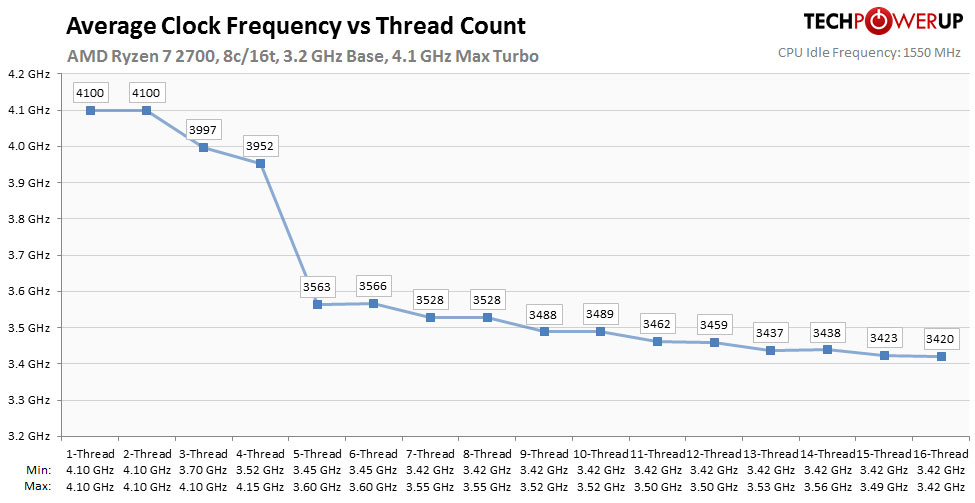 24
24
AMD Ryzen 7 2700 3.2 GHz Review
Power Consumption & Efficiency »Clock Frequencies and Boost Clock Analysis
Most modern processors feature a capability called "Boost" or "Turbo" that automatically overclocks the CPU beyond the nominal clock frequency provided certain conditions related to thread-count, power-draw, and temperatures are met. Our testing on this page investigates what actual real-life frequencies can be achieved in such scenarios. The data below presents the minimum, maximum, and average clock frequency of a given core/thread-count combination for a typical heavy workload. We start with one thread and go all the way up to the CPU's maximum thread count while at the same time measuring the average clock frequency for these timed testing runs.
Looking at the results, it becomes clear that the Ryzen 7 2700 will run near its highest boost clock with only two threads to then drop frequencies a little bit for three and four threads, after which a big drop reduces clocks to roughly 3.5 GHz, which sets the clock range for all additional thread count increases.
This got us curious, and we tested the Ryzen 7 2700's boost clock behavior for a comparison to its pricier sibling, the Ryzen 7 2700X, and the previous-generation flagship part, the Ryzen 7 1800X.

The data above springs up some interesting results. The top-dog Ryzen 7 2700X has a nearly linear reduction in boost clock speeds with an increase in threads, keeping up with AMD's claims of assured boost frequencies for each thread (which is the cornerstone of the multi-threaded performance uplift of Zen+).
The Ryzen 7 2700, on the other hand, also boosts clock speeds of all cores beyond the nominal clock of 3.20 GHz; however, its graph isn't as linear as the 2700X. There's a more pronounced drop in boost clocks beyond 4 threads, after which there's some semblance of linearity. Even with a 16-thread workload, you get some boost (of 200 MHz above nominal).
The previous-generation Ryzen 7 1800X works as expected. There's a linear drop in clock speed as you go from 1-thread to 4-thread, beyond which there's no boost clock, and parallelized workloads have to make do with nominal clocks of 3.70 GHz.
When not loaded at all, the processor's idle clock is 1550 MHz.
May 8th, 2024 02:22 EDT
change timezone
Latest GPU Drivers
New Forum Posts
- Dell Workstation Owners Club (3063)
- Does anyone here overclock their video cards? Is it really worth it? (19)
- Rx 580 gts black edition (0)
- Arc OC'ing, anyone? (5)
- POLL: Can you see the difference past 60fps (gaming/other) (18)
- Download Windows 10/11 ESD (1061)
- GPU Hot Spot Temperature 105 Celsius, fans at 3000 RPM, while GPU Temperature is max 70 Celsius (43)
- Steam Deck Owners Clubhouse (389)
- What are you playing? (20600)
- What's your latest tech purchase? (20474)
Popular Reviews
- CHERRY XTRFY M64 Pro Review
- Corsair iCUE Link RX120 RGB 120 mm Fan Review
- Finalmouse UltralightX Review
- Cougar Hotrod Royal Gaming Chair Review
- Upcoming Hardware Launches 2023 (Updated Feb 2024)
- Meze Audio LIRIC 2nd Generation Closed-Back Headphones Review
- AMD Ryzen 7 7800X3D Review - The Best Gaming CPU
- ASRock NUC BOX-155H (Intel Core Ultra 7 155H) Review
- ASUS Radeon RX 7900 GRE TUF OC Review
- Sapphire Radeon RX 7900 GRE Pulse Review
Controversial News Posts
- Intel Statement on Stability Issues: "Motherboard Makers to Blame" (258)
- AMD to Redesign Ray Tracing Hardware on RDNA 4 (202)
- Windows 11 Now Officially Adware as Microsoft Embeds Ads in the Start Menu (167)
- NVIDIA to Only Launch the Flagship GeForce RTX 5090 in 2024, Rest of the Series in 2025 (134)
- Sony PlayStation 5 Pro Specifications Confirmed, Console Arrives Before Holidays (119)
- AMD's RDNA 4 GPUs Could Stick with 18 Gbps GDDR6 Memory (114)
- NVIDIA Points Intel Raptor Lake CPU Users to Get Help from Intel Amid System Instability Issues (106)
- AMD Ryzen 9 7900X3D Now at a Mouth-watering $329 (104)